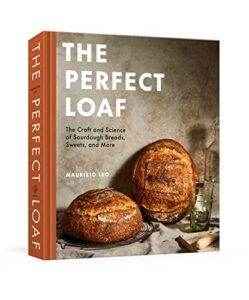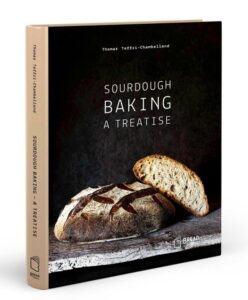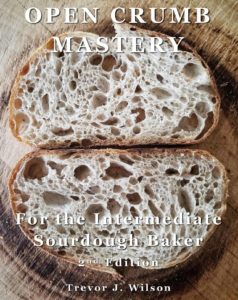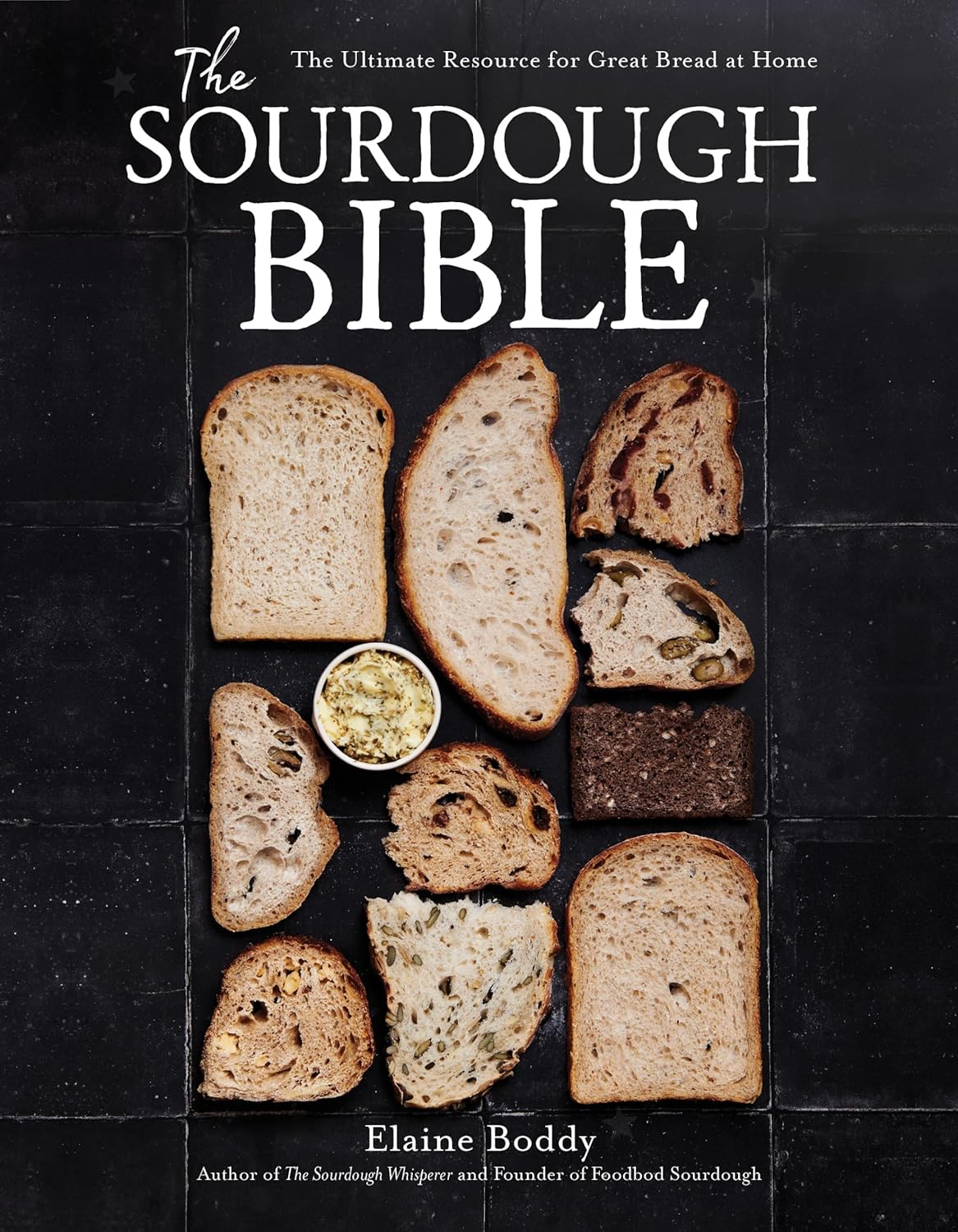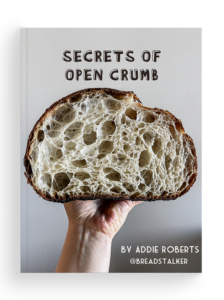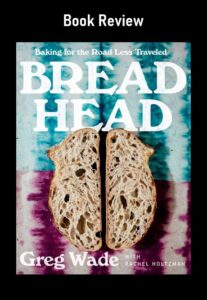books
recommended books
I have read and can recommend the following books. My comments pertain primarily to the sourdough instructional content in each book. I do not test a lot of the specialty recipes in these books.
I purchase most of these books, but I also receive preview copies of some of these books. I have no commercial affiliation with any of the authors or publishers.
Click on the image of each book to link to purchase information.
Some of these are affiliate links (I may receive a small commission).
Tartine Bread, by Chad Robertson
Chad Robertson’s Tartine Bread, published in 2010, began the recent artisan sourdough revolution. This was my first sourdough book and it is still the book I rely on most often. The Tartine Basic Country Bread recipe is the “mother recipe” from which all modern, high-hydration sourdough recipes are essentially derived. This recipe is well-known and is the basis for all of my experimental videos, so it is a helpful companion book to my videos.
Tartine Bread includes over 60 pages of detailed descriptions of the bread-making process and you will find that many modern sourdough techniques are derived from Robertson’s approach.
Recommendation: Highly Recommended!
Bread Book, by Chad Robertson with Jennifer Latham
Bread Book is Chad Robertson’s 2021 follow up to his classic, Tartine Bread. This new book is still largely based on the classic “Country Bread” recipe and process that launched the high-hydration, open-crumb sourdough movement when it was published in 2010.
There are some important updates to the Tartine method in this new volume. In particular, Chad describes in more detail his updated methods for preparing the “young leaven” he uses for the Country Bread. Also, the upfront mixing steps are expanded to develop more gluten strength early in the process (the original method was known to “undermix” the dough). It also includes some important updates regarding bulk fermentation temperatures, and the pre-shaping and final shaping instructions are clarified.
For beginners, I still prefer the detailed instructional content of the original Tartine Bread, but for Tartine enthusiasts, this volume is an essential purchase.
It also includes vastly more recipes than the original book, including many whole grain recipes, and gluten-free recipes.
This book is less well-known that the original, but it deserves as much attention, in my opinion.
Recommendation: Highly Recommended!
The Perfect Loaf, Maurizio Leo
Maurizio Leo’s new book, The Perfect Loaf, picks up where Chad Robertson’s Tartine ends. Maurizio is a self-taught home baker steeped in the Tartine Method. Maurizio has helped thousands of home bakers hone their craft over the last 10 years on his award-winning website, The Perfect Loaf (www.theperfectloaf.com).
Now Maurizio combines the basic Tartine method with hundreds of tips, recommendations and modifications based on his vast knowledge and experience.
In addition, the book includes 60 recipes covering the complete spectrum of sourdough baking productions. The recipes not only include country loaves, sandwich loaves and tasty loaves featuring add-ins, the book also includes recipes for sourdough naan, pita, tortillas, muffins, pretzels, sweets and more. Maurizio is unapologetically “all sourdough, only sourdough” in this unique collection of recipes.
The Perfect Loaf is the heir apparent to Tartine Bread as the go-to book for sourdough home bakers.
Read the full review here.
Recommendation: Highly Recommended!
Bread, by Richard Hart and Laurie Woolever
Richard Hart baked at Tartine in San Francisco with Chad Robertson, and at top bakeries and restaurants in London and Copenhagen. Richard’s methods will sound familiar to those who know the Tartine method. His sourdough process is essentially similar with a few tweaks to create his City Loaf Master Recipe, which is a cleverly-named first cousin of Robertson’s Country Loaf. His process steps are straightforward and plainspoken.
Richard’s book shines in his interesting recipes, especially European-influenced rye, wheat, barley, oats, semolina and spelt breads, and all the classic forms (some sourdough and many yeasted). The detailed panettone and lievito madre method is not found in many bread books.
Recommendation: Highly Recommended!
Sourdough Baking – A Treatise, by Thomas Teffri-Chambelland
If you like sourdough and you like science, this is the book for you. Published in English in 2021, Treatise is loaded with never-before-seen scientific insights into all aspects of the baking process. The author, a former biologist, goes deep into the science of starters, flour, fermentation and baking but also boils down the key points into plainspoken summaries supported by simplified charts and illustrations.
This book is best suited for science-minded intermediate to professional sourdough bakers. It includes over 30 sourdough recipes including wheat classics, gluten-free loaves and Teffri-Chambelland’s award-winning panettone recipe and process. The recipes are concise and presented in short form assuming you are applying the principles of theory and practice described in the first two sections of the book.
I compare this book in some ways to Modernist Bread based on its scientific pedagogy. But this book is more concise and approachable as it is solely focused on sourdough, not all types of breads. One of my new favorite sourdough books! Interestingly, the book covers many of the topics explored in my YouTube experimental videos. A great companion set.
Read the full review here.
Recommendation: Highly Recommended!
Modernist Bread, by Nathan Myhrvold and Francisco Migoya
Modernist Bread is a six volume set and is in a class by itself, both in content and price. This 2,500 page series is a groundbreaking masterwork. It includes bread-making history, science, microbiology, techniques, experiments and recipes. The book set is quite difficult to explain because you’ve likely never seen anything like it. It is part history book, scientific textbook, cookbook and art book combined into one. The science and research behind this book is unparalleled and the photography is breathtaking. For science-loving bread bakers, this is the one book you will covet.
Modernist Bread is very expensive (approximately $550 USD) compared to other baking books, but it is inexpensive when you consider unique content, quality and sheer size. It weighs 52 pounds and takes months to read in its entirety. It is also a superb reference book which I consult frequently. Save up your money for this one. It is a lifetime investment for serious bread bakers.
Recommendation: Highly Recommended!
Open Crumb Mastery, by Trevor Wilson
Trevor Wilson’s popular e-book is an extraordinary deep dive into the world of artisanal sourdough baking. Wilson’s book is well-known among sourdough enthusiasts and it marked a breakthrough for me when I read it in the summer of 2020. Wilson describes, with authenticity, depth and humor, what you will come to recognize as “The Sourdough Obsession” — the continuous search for the perfect loaf.
No one does it better than Wilson in describing the small tweaks, the subtle nuances, and the fleeting, elusive moments in the quest for the perfect loaf. Wilson gives names to the previously nameless tradeoffs instinctively employed by the most experience bakers and he explains them in an understandable, logical manner. This book is one-of-a-kind inside look into the sourdough baker’s mind.
Recommendation: Highly Recommended!
Bread Science, by Emily Buehler
Emily Buehler’s “Bread Science” is an essential part of any breadmaker’s reference library if you are into the science of bread. It covers, not only sourdough but all types of bread. It is a well-researched summary of all the elements of the basic science of breadmaking. Emily explains each topic in a pragmatic, approachable style, and includes illustrations to simply complex topics.
Most importantly, Emily cites all of her sources. It a compendium of over 100 years of breadmaking research. The only comparable book I have seen is Modernist Bread, which is much more detailed, but also a pricier (and heavier!) volume. Thomas Teffri-Chambelland’s, “Sourdough Baking: A Treatise,” is the best breadmaking instructional book which also includes much of the science.
Recommendation: Highly Recommended!
The Sourdough Bible, by Elaine Boddy
Elaine builds on the success of her three previous books, with her new release, “The Sourdough Bible.” Elaine understands the challenges of beginning sourdough bakers and her plainspoken style is unparalleled.
Elaine’s “Master Recipe” has been the starting point for so many beginning sourdough bakers. I don’t know if anyone has impacted beginning bakers as much as Elaine. This book is a great starting point for beginning sourdough bakers.
This book includes much of the great content from the previous volumes and adds more troubleshooting tips, process photos, and additional recipes.
Recommendation: Highly Recommended
The Sourdough Whisperer, by Elaine Boddy
Elaine’s new book, “The Sourdough Whisperer,” builds on the success of the “Master Recipe” from her Foodbod blog. Elaine popularized a simplified, overnight sourdough method which is wildly popular among beginning bakers. In this book, Elaine elaborates on the Master Recipe and includes plainspoken, direct answers to dozens of frequently asked questions. She also includes troubleshooting sections on starter maintenance, fermentation and scheduling timetables.
In addition to the technique, the book includes 40 sourdough recipes including classic loaves, sweet loaves and creative flavor combinations in a variety of savory loaves.
This is a great companion guide to those who follow Elaine’s method, or for new bakers looking for a simplified approach to sourdough baking.
Read the full review here.
Recommendation: Highly Recommended (and very popular!)
Secrets of Open Crumb, by Addie Roberts
Addie Roberts’ new e-book, “Secrets of Open Crumb,” is a great new addition to your sourdough library. Addie is a home baker whose spectacular crumb photos earned her a large, loyal following on Instagram over the past few years (@breadstalker_).
Addie’s book is similar to Trevor Wilson’s classic e-book, “Open Crumb Mastery.” Both are less traditional instructional books, and more of a personal history of each baker’s sourdough journey. Addie describes each the specialized techniques that produce her consistently eye-popping crumb photos, and she describes the background of how she learned, developed, and modified her techniques to produce the results.
The “recipe” section of the book is not really standard recipes, but rather nine actual bakes of Addie’s favorite recipes, including the full details of starter preparation, flour choices, fermentation times, baking techniques, and photos of the actual loaves made in that bake.
The book is a little pricey for an e-book at $25, but it really does contain “secrets” to Addie’s spectacularly consistent crumb – her unique starter maintenance and baking techniques, in particular – that you will not find anywhere else.
Read the full review here.
Recommendation: Highly Recommended
How to Bake MORE Bread, by Michael Kalanty
This book is the 2016 “sourdough” follow up to Michael Kalanty’s worldwide classic, “How to Bake Bread.” Nearly every sourdough baking book written since 2010 is a derivation (i.e., rip-off) of Tartine. This book lives in an alternate universe where Chad Robertson’s classic, Tartine Bread, does not exist. It is a refreshing departure from the Tartine copycats.
I followed the Tartine method religiously for years, but it was not until I read this book that I realized the “French Country Loaf” a la Tartine, is an Americanization of the French classic. Michael’s book, and his spectacular Pain au Levain recipe, take you back to the true French country loaf in the French bakers’ tradition. Loaded with tips, tricks and wonderful instructional content, “…MORE Bread” is required reading for any intermediate to advanced sourdough bakers.
The two-stage bulk fermentation method (short warm start, long cool finish) is worth the price of the book, by itself.
Recommendation: Highly Recommended
Modernist Bread, At Home – by Nathan Myhrvold and Francisco Migoya
I have a copy of the original five-volume set,” Modernist Bread,” and was happy to receive a preview copy of the new, condensed version, “Modernist Bread, At Home.” The new version focuses on essential techniques and the most popular recipes from the original work, with some new content. The book covers both sourdough and commercial yeasted breads.
Similar to the original set, the new version is a beautifully designed book with an easy-to-read layout, gorgeous photos, and a unique combination of both science-based and practical content. The photos are also incredibly informative showing dough handling steps, and side-by-side comparisons of different breads.
I generally review new books primarily based on the sourdough instructional content. Because this book covers both sourdough and yeasted breads, it compromises on deep sourdough content, and it can be a challenge in some sections for the reader to sort out the sourdough versus non-sourdough content.
The book is accessible and relevant to home bakers, but slightly skewed toward commercial bakers. For example, all the techniques and recipes assume machine mixing of the dough, rather than hand mixing methods more commonly used by home bakers. Many recipes (including some of the “sourdough” recipes) include added instant yeast, which is a practicality in a production baking environment, but uncommon among sourdough purists. I was also hoping for more detailed content on sourdough starter maintenance, bulk fermentation and many of the challenges facing home bakers.
The book includes approximately 150 pages of detailed instructional content, and another 150 pages of recipes. The recipes are excellent and cover the gamut of the most popular bread recipes. This is the first book I would consult for classic yeasted recipes like bagels, focaccia, ciabatta, baguettes, and sandwich loaves. The main book also comes with a 150-page companion spiral-bound “Kitchen Manual” which includes all the recipes (without the photos), on plasticized paper for use in working kitchen environment.
The Bottom Line: A fantastic resource for bread bakers, including “essential” sourdough content.
Babette’s Bread, by Babette Frances Kourelos
Babette Kourlos apprenticed with legendary French Master Baker, Gerard Rubaud, and she shares her baking knowledge in this beautifully-written book about breadmaking and bread. Babette has been baker her entire adult life and she shares her stories and wisdom, along with dozens of interesting recipes – many influenced by her Greek heritage and international experience. Her writing style immediately draws you in.
The sourdough instructional content covers the basics of creating a starter and includes a few sourdough recipes.
Most of the book is devoted to lovely recipes for yeasted breads of all shapes, sizes, flavors, and types. Babette’s unique recipes utilize preferments (poolish, biga), and a chapter devoted cold-fermented breads which are yeasted breads pre-fermented in the refrigerator. The loaves featuring Kalamata olives and sesame seeds caught my attention – and a Montreal bagel recipe which I have not seen often. All of the recipes are straightforward and uncomplicated.
Recommendation: Sourdough basics, and lots of interesting bread recipes with an international flavor.
Bread Head, by Greg Wade with Rachel Holtzman
Greg Wade is the Head Baker at Publican Quality Bread in Chicago. His new book, Bread Head, was published in October 2022. Bread Head adequately covers the basics of sourdough baking, but Greg’s passion is apparent when he discusses the organic grains from the American Midwest.
Where Bread Head really shines is in the 200+ pages of one-of-a-kind recipes exalting the unique flavors and qualities of humble grains such as wheat, rye, sorghum, buckwheat, corn, oats, and millet. I quickly leafed through the recipes to find the obligatory Farmhouse Sourdough Loaf, but I lost my boring white-bread sensibilities along the way as I read mouthwatering recipes for a Chile Polenta Loaf, Roasted Garlic and Mashed Potato Ciabatta, Spelt and Apple Muffins, and Rye Focaccia.
In addition, Bread Head includes a unique chapter for bread and pizza recipes baked over fire, and an unexpected recipe chapter featuring breads of the world such as appam, injera, puri and volkornbrot. Greg rounds out the recipes with tasty sweets such as Cornmeal Whoopie Pies, Oat Doughnuts, Sorghum Blondies, and Whole Wheat Graham Cracker S’Mores.
Bread Head is a breadmaker’s homage to the grains of the American Midwest.
Read the full review here.
Recommendation: Recommended
In Search of the Perfect Loaf, by Samuel Fromartz
Sam Fromartz documents a multi-year bread-baking odyssey which took him to France, Germany, California and other destinations to learn the bread-making process. Fromartz is well-known for his award winning baguettes which are a central theme of the story. More a first-person story than a bread recipe book (although it includes a few recipes) the book focuses on one man’s journey to learn history of breadmaking, and in that process he discovers the colorful backstory of modern bread baking.
Recommendation: Recommended
Flour Water Salt Yeast, by Ken Forkish
Ken Forkish’s popular book, Flour, Water, Salt, Yeast is a great resource for beginning and intermediate sourdough bakers. It is clearly written and refreshingly more prescriptive than some other sourdough baking resources. Forkish is not timid about describing the “one best way” to make bread, and sometimes this clarity is needed to cut through the noise. This book is an excellent companion to Chad Robertson’s Tartine Bread. While not quite a detailed as Tartine, Forkish covers the same ground in a more crisp, digestible format. The book also includes recipes for both sourdough and yeasted breads, and most importantly – pizza! Forkish provides a number of sourdough and yeasted pizza dough options. While I have not yet made many of the recipes in this book, I am certain it will be a go-to resource in the future.
Recommendation: Recommended
Bread: A Bakers Book of Techniques and Recipes, by Jeffrey Hamelman
Jeffrey Hamelman has been a professional baker for over 40 years and is the Director of Baking at King Arthur Flour, where he also teaches. His book is considered the “encyclopedia” of bread by many bakers. Hamelman’s Bread includes sourdough and non-sourdough recipes, and covers virtually every type of bread and bread-related product. I use this book more as a reference resource and did not read the entire book. Many readers have noted (and I agree) that the light printing on a shaded background makes it somewhat difficult to read.
Recommendation: Popular
Easy Everyday Sourdough Bread Baking, by Elaine Boddy
This is Elaine’s follow up to her popular book, “The Sourdough Whisperer.” This book is essentialy a 60-recipe addendum to that book. It only includes four pages of instructional tips and refers the reader to the other book or her website for sourdough baking techniques and methods.
Elaine includes in this book, in her inimitable, pragmatic style, loads of simple, yet creative recipes. Her recipes utilize interesting combinations of seemingly common ingredients to create unique flavor combinations. She also features creative uses of baking pans including loaf pans, muffin tins and cake pans.
If you like to experiment with a variety of flavors and add-ins in your sourdough bread, this is a book for you.
Recommendation: Popular
Sourdough by Science, by Karyn Lynn Newman, PhD
I had high expectations for this book based on the title. I was somewhat disappointed in the limited amount of “science” in the book. It is a sound method and process for sourdough baking, but did not add or explain much beyond what is found in many other sources.
Newman has a wonderful writing style. The book is nicely designed and easy to read. It also has over 50 recipes, many of which look very interesting (I have not made them). A good book for beginning bakers.
Recommendation: Popular
books - other popular titles
I have not read these books but they are popular among sourdough bakers.



